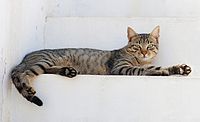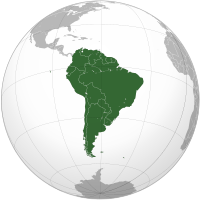
Transmission pathways and spillover of an erythrocytic bacterial pathogen from domestic cats to wild felids
Sign Up to like & getrecommendations! Published in 2018 at "Ecology and Evolution"
DOI: 10.1002/ece3.4451
Abstract: Abstract Many pathogens infect multiple hosts, and spillover from domestic to wild species poses a significant risk of spread of diseases that threaten wildlife and humans. Documentation of cross‐species transmission, and unraveling the mechanisms that… read more here.
Keywords: cmhm; transmission pathways; transmission; wild felids ... See more keywords

Cross‐species transmission of feline herpesvirus 1 (FHV‐1) to chinchillas
Sign Up to like & getrecommendations! Published in 2022 at "Veterinary Medicine and Science"
DOI: 10.1002/vms3.914
Abstract: Abstract Background Herpesviruses are a class of double‐stranded DNA viruses found in both vertebrates and invertebrates. They are usually highly host‐specific and do not easily spread across species. Chinchillas have gradually entered the Chinese pet… read more here.
Keywords: cross species; species transmission; fhv; transmission feline ... See more keywords

The role of domestic cats in the admission of injured wildlife at rehabilitation and rescue centers
Sign Up to like & getrecommendations! Published in 2017 at "Wildlife Society Bulletin"
DOI: 10.1002/wsb.737
Abstract: We reviewed data collected from 82 wildlife rehabilitation centers throughout North America (the WILD-ONe database) during a 3.5-year period to determine common causes of admission and disposition of animals. We found domestic pets to be… read more here.
Keywords: wildlife; domestic cat; domestic cats; wildlife rehabilitation ... See more keywords

Domestic cats (Felis catus) prefer freely available food over food that requires effort.
Sign Up to like & getrecommendations! Published in 2021 at "Animal cognition"
DOI: 10.1007/s10071-021-01530-3
Abstract: Contrafreeloading is the willingness of animals to work for food when equivalent food is freely available. This behavior is observed in laboratory, domesticated, and captive animals. However, previous research found that six laboratory cats failed… read more here.
Keywords: cats felis; domestic cats; freely available; food puzzle ... See more keywords

Factor XII deficiency is common in domestic cats and associated with two high frequency F12 mutations.
Sign Up to like & getrecommendations! Published in 2019 at "Gene"
DOI: 10.1016/j.gene.2019.04.053
Abstract: Factor XII (FXII) is a coagulation protein that initiates surface-activation of the coagulation cascade in vitro. The protein's in vivo role, however, remains poorly defined. Factor XII deficiency, or Hageman trait, is a rare hereditary… read more here.
Keywords: factor xii; domestic cats; f12; xii deficiency ... See more keywords

First record of Hepatozoon spp. in domestic cats in Greece.
Sign Up to like & getrecommendations! Published in 2020 at "Ticks and tick-borne diseases"
DOI: 10.1016/j.ttbdis.2020.101580
Abstract: Feline hepatozoonosis is an emerging disease of domestic and wild felids though there is limited knowledge of this infection, e.g. regarding geographical distribution and parasite species involved. The present study evaluated microscopically and molecularly the… read more here.
Keywords: hepatozoon; record hepatozoon; domestic cats; first record ... See more keywords

Diagnosis and epidemiology of Leishmania infantum in domestic cats in an endemic area of the Amazon region, Brazil.
Sign Up to like & getrecommendations! Published in 2019 at "Veterinary parasitology"
DOI: 10.1016/j.vetpar.2019.08.007
Abstract: Visceral leishmaniasis is a zoonotic disease caused by Leishmania infantum for which dogs are the main reservoir. In South America, presence of this disease is expanding along with increasing dispersion of its principal vector, the… read more here.
Keywords: amazon region; domestic cats; epidemiology; region brazil ... See more keywords

Population genetic structure of European wildcats inhabiting the area between the Dinaric Alps and the Scardo-Pindic mountains
Sign Up to like & getrecommendations! Published in 2021 at "Scientific Reports"
DOI: 10.1038/s41598-021-97401-5
Abstract: Habitat fragmentation and loss have contributed significantly to the demographic decline of European wildcat populations and hybridization with domestic cats poses a threat to the loss of genetic purity of the species. In this study… read more here.
Keywords: alps scardo; dinaric alps; area dinaric; area ... See more keywords

Influence of Vitrification Device, Warming Protocol, and Subsequent In Vitro Culture on Structural Integrity of Testicular Fragments from Adult Domestic Cats.
Sign Up to like & getrecommendations! Published in 2022 at "Biopreservation and biobanking"
DOI: 10.1089/bio.2021.0092
Abstract: The objective of the study was to evaluate the integrity of cat testicular tissues after vitrification with different devices followed by different warming conditions. The influence of vitro culture for 24 hours after warming also… read more here.
Keywords: culture; vitro culture; vitrification; integrity ... See more keywords

Cranial volume and palate length of cats, Felis spp., under domestication, hybridization and in wild populations
Sign Up to like & getrecommendations! Published in 2022 at "Royal Society Open Science"
DOI: 10.1098/rsos.210477
Abstract: Reduced brain size, compared with wild individuals, is argued to be a key characteristic of domesticated mammal species, and often cited as a key component of a putative ‘domestication syndrome’. However, brain size comparisons are… read more here.
Keywords: domestic cats; domestication; cranial volumes; palate length ... See more keywords

Cross‐species transmission of retroviruses among domestic and wild felids in human‐occupied landscapes in Chile
Sign Up to like & getrecommendations! Published in 2021 at "Evolutionary Applications"
DOI: 10.1111/eva.13181
Abstract: Human transformation of natural habitats facilitates pathogen transmission between domestic and wild species. The guigna (Leopardus guigna), a small felid found in Chile, has experienced habitat loss and an increased probability of contact with domestic… read more here.
Keywords: cross species; retroviruses among; species transmission; domestic cats ... See more keywords